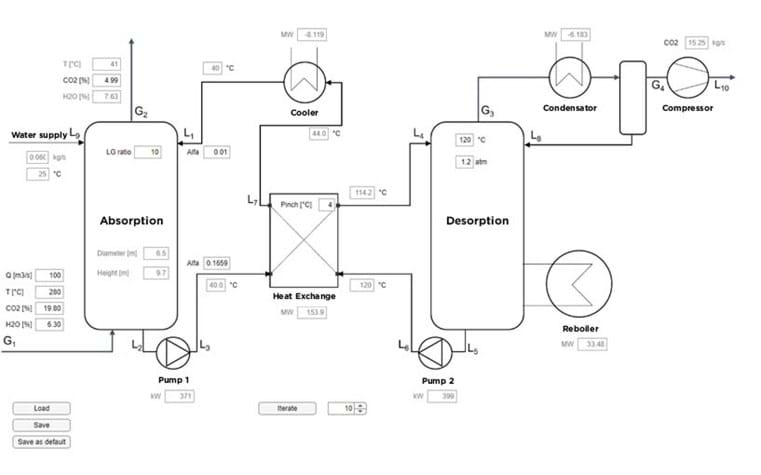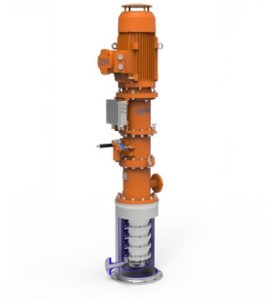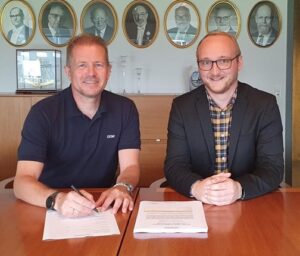Selecting the best pump for CCS applications

Amine scrubbing process for Carbon Capture. Simulation results for cleaning a flue gas with 10% (mol/mol) MEA solution (Image source: DESMI A/S)
The final text of the latest summit, the COP27 in Sharm El-Sheikh, Egypt, includes a provision to boost low-emissions energy. In practice, this means that many different technologies must be used to help cut emissions – including Carbon Capture and Storage (CCS) systems.
What is the potential of CSS?
The International Energy Association (IEA) has provided an excellent overview of the potential of capturing, storing, and utilizing carbon dioxide. It estimates that 45 Mt/year is currently being captured and that this must increase to about 1300 Mt/year in 2030 to meet a net zero emission scenario (NZE). Around 35 facilities are already in operation, and over 200 new facilities are planned to be in operation by 2030. However, this corresponds “only” to 220 Mt/year of CO2 being captured, so facilities for at least an additional 1000 Mt/year will be required soon to meet the NZE target.
Today, most facilities are installed to capture CO2 emitted from natural gas and hydrogen processing plants. Somewhat ironically, the captured CO2 is mainly used for enhanced oil recovery (EOR). However, as oil production must decrease in the future, most of the new planned facilities are aimed for power plants and the cement and steel industries, as these sectors are impossible to electrify completely due to the nature of their raw materials. Furthermore, the captured CO2 should not be used for EOR but stored permanently underground.
How does the CO2 scrubbing process work?
Capturing the CO2 in a scrubber or absorption tower is the most common and well-known method for Carbon Capture. As shown in figure 1, a liquid mixture of water and an organic amine is circulated between an absorber and desorber unit.
The inlet flue gas is brought in direct contact with the liquid in the absorption or scrubber tower. The scrubber is usually a packed-bed type and typically 20-40 meters in total height (only the height of the bed is indicated on the figure). A relatively high tower is required if the concentration of CO2 is low in the flue gas or if high removal efficiencies are required.
The lean amine is fed into the top of the scrubber and is enriched with the CO2 by flowing downwards in counter-current with the flue gas. A first pump is used to force the solution through a plate heat exchanger and to the desorption or stripping tower. The CO2 is released in pure form by heating the liquid in the reboiler section. A second pump is used to force the liquid through the hot side of the plate heat exchanger and back to the absorption tower again. An additional cooler is often required to reduce the evaporation of water in the absorption tower.
Calculating pump operating expenses
The simulation results shown on figure 1 are based on many preliminary assumptions which must be further validated and adjusted as more experience with the process is gained. However, it is interesting to try to relate the calculated pump power to the amount of CO2 captured, as we can thus arrive at an initial estimate of the operating expenses.
As can be seen, 1061 kW of electrical power (496 kW + 565 kW) is used by the two pumps for catching 20 kg/s of pure CO2. This is equivalent to 52 kJ/kg of CO2 or 14 kWh/ton of CO2. If we assume an electricity cost of €0.15/kWh, the operating expense for the two pumps will be €2.1/ton of CO2.
As CCS plants become more widespread and operate with increased capacity, selecting the most appropriate pump(s) for a certain scrubber installation is not a trivial task; particularly considering that 2 or 3 pumps are often installed in parallel to provide some redundancy in the scrubber system. At a CCS plant capable of processing 5 Mt/year, for example, annual operating expenses with the pumps used in the example above would be €2.1 million. At this scale, even small power consumption reductions make a significant difference to the operating economy. Selecting pumps that are sized correctly and operate at or near their best efficiency point (BEP) is an effective way of achieving these cost reductions.
Tips for sizing and selecting pumps
We often see that too much safety margin is added in the design phase so that for most of the time, the pump will run too far from its BEP (the blue line on the Q-H plot in figure 2). In the worst cases, the pump may even run outside our recommended operating area, which is between 70 and 120% of its BEP (the area between the green dotted lines on the Q-H plot).
It is usually better to add a safety margin in the frequency converter so the pump can run at higher RPM in extreme cases where max flow and head might be required. This will save both CAPEX and OPEX as smaller pumps can be installed, and as it will be easier to operate them at their best efficiency point. The pumps will also run with fewer vibrations and generate less heat, meaning that there will be less excess energy that could cause damage.
A low NPSHr value is often required. For the rich amine (pump 1 in figure 1), the solution is almost saturated with CO2 and therefore has a relatively high vapour pressure. For the lean amine (pump 2 in figure 1), the solution will only contain little CO2, but the temperature will be higher and therefore will also cause a relatively high vapour pressure.
Full range of pumps and selection tools
DESMI has developed more than 60 centrifugal pumps of different sizes in the ESL, NSL and DSL series for the scrubbing industry. They are generally designed for low NPSHr values.
Most of the ESL, NSL, and DSL pumps are available in high-grade stainless steel or super duplex steel (SAF2507), which we will usually recommend for a MEA solution based on the latest scientific findings. In addition, we recommend equipping our pumps with a Dual Cartex seal due to the toxicity of the MEA. The sealing system can also be connected to an external barrier fluid to ensure that the gaskets will not exceed their max limit temperatures.
For projects that use a less toxic solution of water and potassium carbonate instead of an amine (for example the Swedish BECCS @ STHLM project), cheaper pump materials and our standard balanced sealing system can be used; the potassium will act as a buffer to ensure an almost neutral pH-value.
All pump curves are available in our selection programme winPSP which you can download from our website. We can also supply an object function or app that allows you to integrate pump selection in your design programme or other commercial simulation software.
Overview of CCS projects
CCS projects are currently in operation and being developed in more than 30 countries all over the globe. Here is a brief overview:
In North America, the United States has about 80 projects, and Canada has about 15 projects in various phases of development
The first project in China was completed in June 2022 and is now due for commissioning.
In the Middle East, four facilities are in operation, and at least four more are in the planning phase.
The EU recently awarded funding to four different projects: Kairos@C, BECCS @ STHLM, K6, and SHARC.
Three major oil companies (Shell, Equinor, and Total Energies) have entered a partnership called Northern Light which aims to store 1.5 Mt/year by mid-2024 and expand to 5.0 Mt/year if required
The port of Dunkirk in France is considered to become a future European CO2 hub with a capacity of 8.1 Mt/year over the first decade, and the LINCCS consortium in Norway is aiming to reduce costs by 70% by optimizing the entire CCS value chain and contributing to the development of new solutions.
Several equipment suppliers to the maritime industry are investigating the possibilities for Carbon Capture on ships. For example, Wärtsila and tank ship operator Solvang are currently installing a pilot project to capture 80% of the CO2 in the exhaust gases and store it onboard as liquid in tanks at -35°C. Shipping accounts for 2.2% of the world’s carbon emissions, or ~800 Mt/year. To put it all into perspective, the global energy-related emission of CO2 was 36300 MT/year in 2021.
Conclusion
If CCS is to make a significant contribution to reaching the world’s climate targets, the technology needs to be developed further. Researchers worldwide are intensively searching for more efficient liquids that require less energy for regeneration. However, this will usually be at the cost of reduced reactivity so that larger scrubbers must be used, or more liquid must be circulated to catch the same amount of CO2. There is little doubt that such challenges will be overcome, and future CCS solutions will become more effective, capturing ever larger amounts of CO2 while using as little energy as possible.
Pumps are not the only important component of a CCS plant, and other components such as compressors and reboilers consume far more electricity. However, given the number and scale of future CCS plants, and given the fact that succeeding at the green transformation will require us to lower energy consumption in all industrial sectors, and all aspects of human life generally, selecting energy-efficient pumps for CCS applications not only makes good financial sense; it is also an effective way of contributing to reaching current and future climate targets.
Source: DESMI A/S




